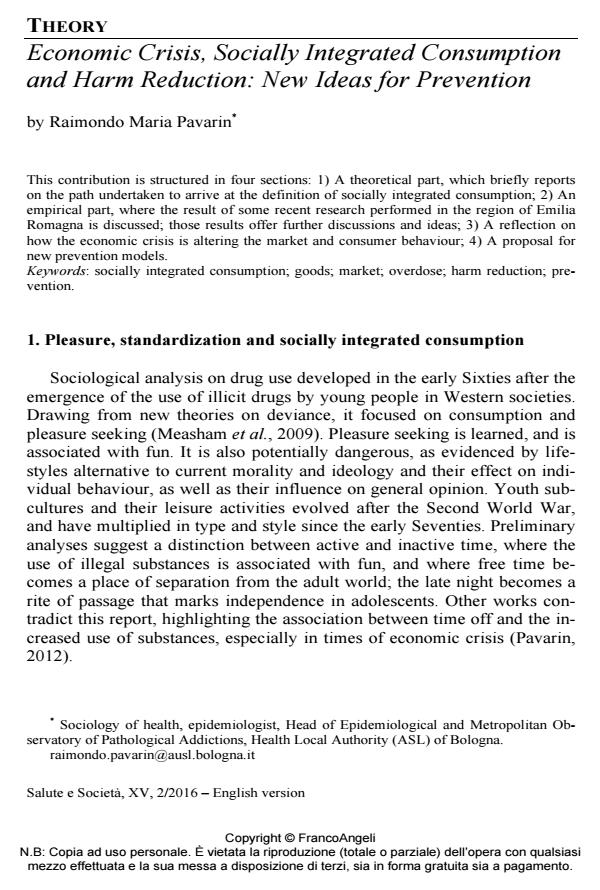Economic Crisis, Socially Integrated Consumption and Harm Reduction: New Ideas for Prevention
Journal title SALUTE E SOCIETÀ
Author/s Raimondo Maria Pavarin
Publishing Year 2016 Issue 2016/suppl. 2
Language English Pages 16 P. 17-32 File size 94 KB
DOI 10.3280/SES2016-SU2003
DOI is like a bar code for intellectual property: to have more infomation
click here
Below, you can see the article first page
If you want to buy this article in PDF format, you can do it, following the instructions to buy download credits

FrancoAngeli is member of Publishers International Linking Association, Inc (PILA), a not-for-profit association which run the CrossRef service enabling links to and from online scholarly content.
This contribution is structured in four sections: 1) A theoretical part, which briefly reports on the path undertaken to arrive at the definition of socially integrated consumption; 2) An empirical part, where the result of some recent research performed in the region of Emilia Romagna is discussed; those results offer further discussions and ideas; 3) A reflection on how the economic crisis is altering the market and consumer behaviour; 4) A proposal for new prevention models.
Keywords: Socially integrated consumption; goods; market; overdose; harm reduction; prevention
- Pavarin R.M. (2014b). Access to the health services for problematic use of illegal psychoactive substances among natives and non-natives: a study in the metropolitan area of Bologna. Ann Ist Super Sanità, 50(1): 38-43. DOI: 10.4415/ANN_14_01_0
- Pavarin R.M. (2015a). Risks, substances and consumers. Studies and surveys in the metropolitan area of Bologna. Mantova: Universitas Studiorum.
- Becker H.S. (1963). Outsiders. Saggi sulla devianza, EGA. Torino: Edizioni Gruppo Abele.
- Cohen P. (1992). Cocaine users in Amsterdam. British Journal of Addiction, 87(7): 1077-1078. DOI: 10.1111/j.1360-0443.1992.tb03126
- Darke S. (2014). Opioid overdose and the power of old myths: What we thought we knew, what we do know and why it matters. Drug and alcohol review, 33(2): 109-114. DOI: 10.1111/dar.1210
- Decorte T. (2001). Quality control by cocaine users: underdeveloped harm reduction strategy. European Addiction Research, 7(4): 161-175. DOI: 10.1159/00005073
- Fischer B., Brissette S., Brochu S., Bruneau J., el-Guebaly N., Noël L., Rehm J., Tyndall M., Wild C., Mun P., Haydon E., Baliunas, D. (2004). Determinants of overdose incidents among illicit opioid users in 5 Canadian cities. Canadian Medical Association journal, 171(3): 235-39. DOI: 10.1503/cmaj.103141
- Grund J.P.C. (1993). Drug Use as a Social Ritual: Functionality, Symbolism and Determinants of Self-Regulation. Rotterdam: The Lindesmith Center.
- Hathaway A.D., Comeau N.C., Erickson P.G. (2011). Cannabis normalization and stigma: Contemporary practices of moral regulation. Criminology & Criminal Justice, 11(5): 451-469. DOI: 10.1177/174889581141534
- Marx K. (1844). Manoscritti economico filosofici del 1844. Milano: Einaudi.
- Measham F., Shiner M. (2009). The legacy of «normalization»: the role of classical and contemporary criminological theory in understanding young people drug use, The International Journal of Drug Policy, 20(6): 502-8. DOI: 10.1016/j.drugpo.2009.02.00
- Merton R.K. (1971). Teoria e struttura sociale. Bologna: Il Mulino.
- Parker H., Aldridge J., Measham F., Haynes P. (1998). Illegal Leisure: The Normalisation of Adolescent Recreational Drug Use. London: Routledge.
- Pavarin R.M. (2011). Consumo problematico di alcol e accesso ai servizi di non nativi: healty or happy migrant effect?, Rivista di Alcologia, 12: 8-10.
- Pavarin R.M. (2012). Dal deviante clandestino al consumatore socialmente integrato. L’evoluzione della ricerca sull’uso delle sostanze psicoattive. Bologna: CLUEB.
- Pavarin R.M. (2014a). Il consumo socialmente integrato di sostanze illegali. Danni, precauzioni, regole e mercato. Milano: FrancoAngeli.
Raimondo Maria Pavarin, Economic Crisis, Socially Integrated Consumption and Harm Reduction: New Ideas for Prevention in "SALUTE E SOCIETÀ" suppl. 2/2016, pp 17-32, DOI: 10.3280/SES2016-SU2003